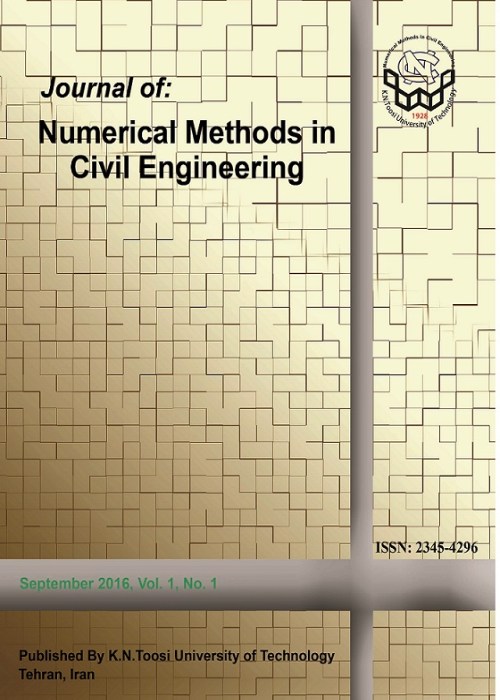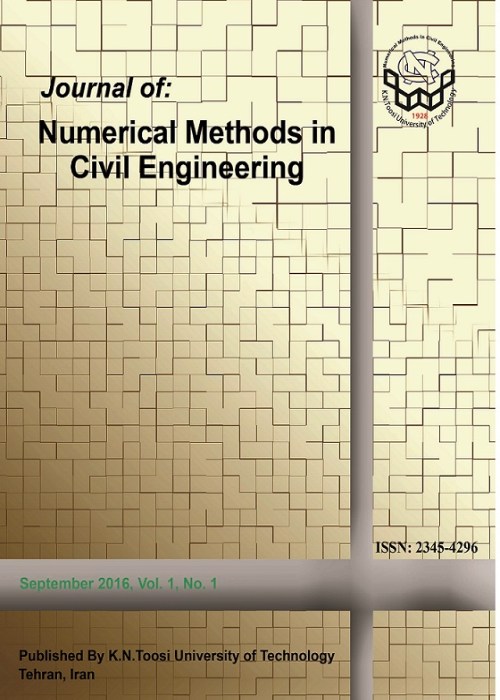فهرست مطالب

Journal of Numerical Methods in Civil Engineering
Volume:7 Issue: 4, Jun 2023
- تاریخ انتشار: 1402/04/12
- تعداد عناوین: 8
-
-
Pages 1-11The growing number of roller compacted concrete dams built around the world demand good methods to reduce the risk of thermal cracks. In roller compacted concrete dams, usually, large amounts of concrete are poured in a short time and the heat generated by the hydration of the cement, leads to an increase in temperature in the body of the dam, which results in a significant heat slope. In this research, Abaqus software, a finite element software, was used for thermal analysis of the dam during construction and concreting. The method of applying thermal changes is as follows. For the structure, hypothetical 50 cm layers are considered, each layer takes up 72 hours of analysis time. In general, the problem under analysis is analyzed 12 times. Each analysis is based on the start of the project from different months of the year to achieve the optimal constructing time based on the maximum temperature in the concrete of the dam and the stresses created by it by collecting the information and using the perceptron network algorithm. Perceptron algorithm and machine learning were performed on the 12 mentioned analyzes and then the process output was generated for 365 days of the year as the start of the project. Finally the optimal time to start construction was achieved.Keywords: Dam construction time, Dam construction temperature, structural analysis, optimization, Roller compacted concrete dam
-
Pages 12-23In this research, a multilayer feed-forward backpropagation error neural network has been used to predict the strength parameters of a concrete sample containing different additives. To achieve the most optimal neural network structure, the strength parameters of the concrete have been evaluated for different neural network arrangements. Control criteria are the use ofnumerical values of performance, the correlation between training functions, validation and,testing in the neural network, gradient and results of regression diagram to determine the most optimal neural network structure. It was found that the function of the neural network largely depends on its geometric structure. Revealed by the research findings, the most optimal prediction of the neural network has occurred in the case of using three layers with 30 neurons in each layer in the neural network. In this case, the numerical value of the neural network performance and the regression were obtained as 58.5 × (10-9) and 0.9846 , respectively. By determining the optimal neural network, different percentages of concrete raw materials based on the pre-performed experimental study are introduced to the selected neural network and the considered resistance parameters are predicted through residual analysis. According to the results, the differences between the predicted values of the neural network and the numerical values of the experimental study concerning the parameters of compressive, flexural, and tensile strength were also found to be equal to 1.68%, 1.92%, and 0.21%, respectively. Such a slight difference reflects the optimal accuracy of the chosen neural network in predicting the strength parameters.Keywords: Strength parameters, Feed Forward, Back-propagation, Regression, additives, Residual Analysis
-
Pages 24-34
Cable bracing has many advantages, such as high tensile strength and lack of buckling in evaluation with traditional braces, the use of a cable as a brace is necessary. The aim of the present research is the use of cable bracing with a new configuration so that all cables remain in tension. For this purpose, a diamond cable bracing system for steel Structures was proposed. Sap2000 software was used to model the cables and rings. It was found that the proposed system eliminated the main weakness of the x-shaped cable bracing system. Ability to install for existing structures, easy installation, and repair, lightweight and delicate dimensions are the capabilities of this type of bracing, which makes its use in the field of reinforcement significant. Increasing or reducing the diameter of the cables can control the amount of displacement. Among the studied models, MRF has the least amount of axial force applied to the beams. By adding steel cable braces to the frame, a large amount of axial force is added to the floor beams. In this case, by increasing the diameter of the cables, the amount of this force can be reduced.
Keywords: Cable bracing system, ring, retrofitting, Steel structures, Cable configuration -
Pages 35-49In this paper, we compare computational design of box culverts using Kleinlogel’s formulas and three-dimensional models based on Winkler and Modified Vlasov Foundation (MVF) by Radial Point Interpolation method (RPIM) . In order to extend the RPIM to the study of box culverts, a method of decomposition by subdomain and a creation of a fictitious rotation is made. Similar results are observed between the RPIM_Winkler and STAAD PRO (FEM software) with fewer nodes in the case study. The Kleinlogel’s formulas or the Winkler model gives a maximal increase in stresses at the middle of the raft of 5%, and a 12 times increased displacement. Finally, it emerges that for the same type of soil and a single structure, the reaction and shear modulus of the soil are highly dependent on the distribution of loads on the structure.Keywords: Box culvert, Winkler foundation, Modified Vlasov Founda-tion, RPIM, Kleinlogel’s formulas
-
Pages 50-65
Considering the recent human activities and the resulting climate change in optimizing the operation of the dam reservoir, the effects of climate change should be noticed. In this research, in order to extract command curves by dolphin echolocation and gravitational search algorithms, the monthly inflow of the reservoir, the reservoir storage volume, and the downstream demand of the reservoir in case of climate change were calculated .The optimal output values of the reservoir of Lar Dam (located in Larijan, Amol City) were determined by the approach of minimizing the total square of the monthly relative deficiencies in supply demand and climate change conditions based on the river flow According to the research, by using HADCM3 and scenarios RCP2.6, RCP4.5, and RCP 8.5, climate change has increased the maximum temperature by 5%, 5.2%, and 6.2%, respectively. It has increased the minimum temperature by 3.5%, 5.6%, 5.17%, and increased precipitation by 8.5%, 9.5%, and 13%, respectively. In addition, the runoff from the intermediate scenarios indicates an increase of 3.3% compared to the base period. Moreover, to examine the water allocation policies required downstream, two future and basic conditions are considered. In this study, reservoir efficiency indices in the conditions of (future) climate change and their corresponding values in the base period were compared. The execution results of each of the algorithms show that the execution speed of the DE algorithm is much higher than the GSA algorithm, as well as, in the conditions of climate change, the reliability index in the dolphin echolocation and gravity search algorithms has increased. 9.73 and 12.46% Vulnerability has decreased by 21.4% and 26.51%, respectively, and reversibility has increased by 18.27% and 17.64%, respectively. The execution results of each of the algorithms show that the execution speed of the DE algorithm is much higher than the GSA algorithm. Furthermore, in the conditions of climate change, the reliability index in the dolphin echolocation and gravity search algorithms has increased 9.73 and 12.46% Vulnerability has decreased by 21.4% and 26.51%, respectively, and reversibility has increased by 18.27% and 17.64%, respectively.
Keywords: Dolphin echolocation algorithm, climate change, climate scenarios, Gravitational Search Algorithm, Rainfall-Runoff -
Pages 66-88
This research aims to investigate the analytical procedure of constructing the moment-rotation curve for top and seat angle, and stiffened welded-seat connections using Chisala’s model. As these connections practically exhibit a semi-rigid flexural performance, the moment-rotation curve appears to provide useful information and helpful vision on their performance for design engineers. Since the process of determining the precise moment-rotation curve for a steel connection is costly due to the need for laboratory experiments or heavy finite element computations, using a precise and straightforward analytical model appears to be more feasible. Chisala’s model, having fewer and independent parameters, is precise and easy to construct, which is fit for the purpose. In this regard, the procedure of constructing the analytical model for both types of connections using Chisala’s model is explained, and the key parameters of Chisala’s model are determined. As a means of verification, finite element models of both types of connections were constructed as well, using Abaqus software. To ensure that the results are not accidental, a total of 34 TSA (Top and Seat Angle), and 33 SWS (Stiffened Welded-Seat) connection specimens with different geometric dimensions were tested, and the effects of geometric dimensions on the flexural performance of each type as side results were described. Based on the obtained data, analytical and numerical moment-rotation curves, for both types of connections, were illustrated. The results suggest that Chisala’s model can precisely predict the moment-rotation curve for the mentioned types of connections, provided that a proper equivalent analytical model is created
Keywords: Chisala’s model, Moment-rotation curve, Top, seat angle connection, Stiffened welded-seat connection, finite element analysis -
Pages 89-100
The collapse risk role has increasingly drawn engineers’ attention in the performance-based design field and engineers tend to design the structures in a way to be qualified enough to resist earthquakes, especially at near-fault sites. Due to specific characteristics of near-fault records, structures in near-fault required more collapse capacity in comparison with far-fault sites. Furthermore, it is necessary to determine the collapse capacity that structures should be designed to comply with standards and to meet the collapse risk limit in the given site. In this research, the ratio method is presented to determine the design collapse capacity of structures based on the risk value of 1% in 50 years as well as the site hazard stemming from the integration scenario for near-fault. In this method, the structure behavior and fundamental period are incorporated, and effect of pulse period is considered as well. This method utilizes the ratio of the collapse capacity of the structure in near-fault to that of far-fault named γ. Consequently, efficient procedures based on nonlinear static pushover are used for obtaining the collapse capacity in far-fault and near-fault. Then, the ratio method is employed on a mid-rise RC frame and the design collapse capacities are acquired for two amounts of Tp/T. The result shows ratio method can be used for any Tp/T values especially those corresponding to the governing Tp at site. Moreover, the least value of γ can be used conservatively since the design collapse capacity of the structure in near-fault is raised by reducing γ.
Keywords: Homa Shanesazzadeh, Mohsen Tehranizadeh *, Leila Haj Najafi -
Pages 101-110
To improve the design of surface structures built on underground structures for safety and earthquake resistance, it is necessary to study the effects of the underground structures on wave propagation scattering and surface ground acceleration. To this end, various parameters must be studied, including input motion, structure embedment, and dimensions of different subway stations. The present study focuses on these parameters by employing a nonlinear cyclic model called ARCS soil's shear modulus reduction and damping ratio increase corresponding to those given by the user. The variations in spectral ratio, affected period range, peak ground acceleration, and peak relative lateral displacement versus relative distance under near-fault and far-fault earthquakes are presented. The results indicate that different amplification or de-amplification effects at different surface positions were produced at each frequency by appearing a significant influence on the dynamic behavior of ground surface, soil layers, and the surface structure when a subway station is present. A 1.3 times increase in the surface ground acceleration when subjected to far-fault earthquakes and a 1.6 times increase in the relative displacement indicated that study parameters have significant influence on the amplification ratio and scattering of wave.
Keywords: Subway station, Near-Fault, Far-Fault earthquakes, Spectral ratio, Scattering of the wave, Nonlinear cyclic model


